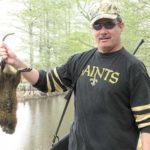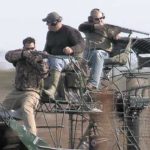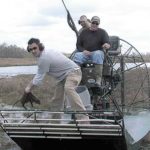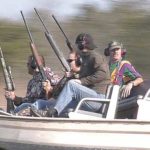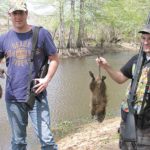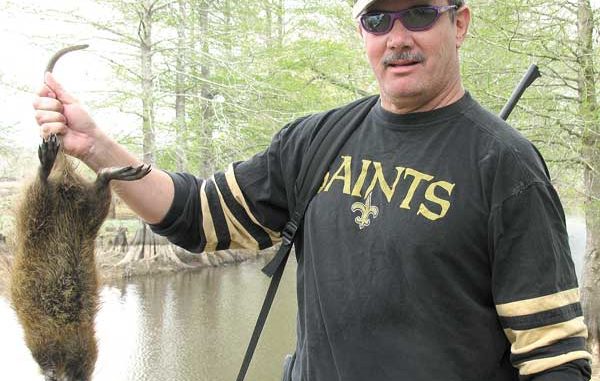
An American hero gets some respite – South Louisiana style!
Remember in The Deerhunter when De Niro, after barbecuing the commie with the flamethrower then perforating him with his own AK-47, gets knocked down by a spate of explosions? Then he and his handful of dazed chums get up, look down groggily through the smoke, and see a horizon full of commies charging their way?
The scene, you might recall, then shifts to some festive gambling sessions, involving Russian roulette.
On June 25, 2005, among the high peaks of the desolate Hindu-Kush Mountains of northeast Afghanistan, four U.S. Navy Seals looked up and saw much worse than De Niro saw in The Deerhunter.
More than 150 Taliban terrorists had spotted the handful of elite (though theTaliban didn’t know it) U.S. warriors, and were already closing in, positioning themselves to outflank, isolate, trap, then … well, many of us have seen the video of Nick Berg’s beheading.
But in fact, Berg’s horrifying murder is not fully typical of Taliban and Al Qaeda sadism. According to what Taliban defector Hafiz Sadiqulla Hassani told London’s Daily Telegraph, Berg’s murderers were sentimental chumps, softies.
“You must become so notorious for bad things that when you come into an area people will tremble in their sandals,” instructed the leaders of the Taliban our boys are still fighting in Afghanistan. “Anyone can beat and starve people. I want your unit to find new ways of torture so terrible that the screams will frighten even crows from their nests and if the person survives he will never again have a night’s sleep. … We beat a man so much, to such a pulp of skin and blood, that it was impossible to tell whether he had clothes on or not. Every time he fell unconscious, we rubbed salt into his wounds to make him scream. … We would stretch the arms out of others and nail them to posts like crucifixions. … Nowhere else in the world has such barbarity and cruelty as in Afghanistan.”
Last year, according to the Telegraph, 10 French NATO soldiers were captured by the Taliban and skinned alive.
“I will never quit,” reads the Navy Seal motto. “I persevere and thrive on adversity. My nation expects me to be physically harder and mentally stronger than my enemies. If knocked down, I will get back up, every time. I will draw on every remaining ounce of strength to protect my teammates and accomplish our mission. I am never out of the fight. … Once you send me over there, take the leash off of me, I’m going to create so much hell, do everything I can to annihilate everything in front of me so that they are never going to attack us again. … We’re getting it done.”
Heck, I find a fat fox squirrel in my .22 scope, and get the shakes! To say nothing of the reaction when lining up on a fat spike from my quaking climbing stand!
Navy Seal Marcus Luttrell, on the other hand, noticed that one of those terrorists had snuck in close.
“I thought I saw movement,” he writes in his bestselling book, Lone Survivor. “Then it was confirmed, first by a turban, then by an AK- 47, its barrel pointed in my direction. … I tightened my grip on my trusty rifle. I kept perfectly still — that’s completely motionless, like a marble statue. Suddenly a hook-nosed Taliban warrior was peering straight at me through black eyes above a thick black beard. The barrel of his AK was pointed straight at my head. Had he seen me?
“I fired once and blew his head off. Then all hell broke loose.”
This hell consisted of the concentrated firepower of 150 Taliban warriors armed with AK-47s and rocket-propelled grenades — coming from the high-ground no less — all blasting and blazing and pinging and whizzing and ricocheting and exploding around the four U.S. Navy Seals, as the mob of terrorists charged downhill after them.
Compounding the “thrill,” their radio went out.
“Danny, Danny! For Christ’s sake get that … thing working!” yelled Navy Seal Michael Murphy to Navy Seal Danny Dietz, who got nowhere with the malfunctioning gizmo despite every frantic effort to communicate their “predicament” to their base. This malfunction confirmed it: No help in the way of air support or reinforcements would be coming in time.
So what to do? Well, see above.
Marcus and his team found cover, held their ground, carefully picked their targets and started annihilating them — exactly as promised.
But even our four Navy Seals’ super-human valor and skill could not hold out against the sheer weight of 150 Taliban numbers. And a retreat (or “an attack in the opposite direction” in the immortal words of the Marines who blasted their way out of the Chosin Reservoir “predicament” during the Korean War) was finally decided upon by our already wounded and bleeding Seals.
But there was only route open for an “attack in the opposite direction,” and that was down a rock-studded mountain with a gradient Luttrell describes as that of a ski jump.
Down they went, first stumbling, then running, then falling, rolling, tumbling, flipping, somersaulting, stopping at intervals by somehow grabbing branches. This allowed them to ram in clips and continue annihilating (as promised) more of the enemy. In the interim, the Seals were getting their bones broken and flesh lacerated by the rocks and brambles that studded their “ski-jump” — not to mention the Taliban bullets and grenade shrapnel still in hot pursuit.
A day later, Luttrell was the lone survivor of his four-man Seal fire-team. He’d been shot through the leg, blasted unconscious and through the air and down a cliff by a rocket-propelled grenade, had three broken vertebrae, a gashed forehead, lacerated face and both legs riddled with grenade shrapnel, among a few other inconveniences.
So he started crawling, stumbling to … where?
Hopefully to some water, before he literally died of thirst from his profuse bleeding. Alas, the Taliban themselves suspected a lone survivor from the four-man U.S. team, and sent a six-man killer-squad to track him down and finish him off — or preferably, bring him back alive for some of the Taliban diversions mentioned above. Expert trackers, the warriors indeed ran Luttrell down and started blasting —but only managed to wound the already badly wounded soldier with a shot through his upper thigh. The Seal scrambled to cover behind rocks.
Now what?
Luttrell still had a breath in his lungs and a clip in his MK 12 Sniper rifle. So the battered, bloodied — but defiantly unbowed — Navy Seal turned the tables on his pursuers, taking out the Taliban killers one by one, usually with one shot and at close quarters. Over the course of the full battle, Luttrell and his three Seal brothers took out close to a hundred Taliban warriors.
Then the badly incapacitated Luttrell crawled for miles through hellishly rugged terrain before being found and sheltered by a friendly Pashtun tribe that reported his presence to a nearby U.S. base. A week later, he was rescued by a patrol of Army Rangers and Green Berets.
All of his dead Seal brothers were awarded citations for valor, Mike Murphy, the Medal of Honor. President Bush personally pinned the Navy Cross on Luttrell’s valiant breast. His book became a rollicking bestseller, and will soon be a movie.
Last Mardi Gras, the good folks at Orion Multimedia who produce shows for the Outdoor Channel tasked me with showing military hero and bestselling author Marcus Luttrell “some excitement.”
“Why, no problem!” I stammered. “I’ll take him nutria hunting!”
“Great idea,” responded the producers.
In fact, they’d been on an airboat nutria hunt a few months earlier, filming the pilot for a proposed outdoor series titled “Fontova’s Revenge.” So they knew it meant action. Much more importantly, I’d explained in excruciating detail how we’d be selflessly devoting ourselves to a purely altruistic endeavor, immensely beneficial to our wetlands, and thus our environment, and hence the brotherhood of mankind in general, overshadowed as it is in these harrowing times by the looming cataclysm of global warming.
Indeed, I could almost hear the old Coke jingle in the background (“I’d Like to Teach the World to Sing”) as I elaborated on our altruism. Marvin Gaye’s “Mercy Mercy Me, the Ecology” was also audible in the background soundscore. While pouring my heart out, I could almost see Al Gore and Leo DeCaprio smiling approvingly upon me from their celestial greenie thrones.
“We’ll be doing far more for the environment (saving our wetlands) than the greenest Sierra Clubber!” I gushed.
Then I explained the wetland damage wrought by the hordes of nutria that infest South Louisiana, how the state had even put a price on their heads (tails, actually) in the form of a bounty. How these huge rodents eat 25 percent of their weight a day in marsh grasses. And how they especially like the roots, which results in those bald patches, those “eat-outs” we’d see in the marsh.
“Nutria!” I gasped, “munch through 100,000 acres of valuable Louisiana wetlands every year!
“And oh!” I added as an afterthought, “just one more thing. You know, Mardi Gras is right around the corner. So why don’t we plan the hunt for the day after Mardi Gras? And on Mardi Gras night, film some scenes from a Bourbon Street Balcony? Marcus’ show is titled ‘Wild & Raw’ right? Well, it can’t get much wilder and rawer than that!”
As fully befits a guy who devotes most of his book to his departed Navy Seal brothers and who treasures his Texas roots and upbringing and the lifelong friendships forged in this setting, when Luttrell learned he’d have an expense-paid weekend in New Orleans for Mardi Gras, he realized he had no choice but to invite a bunch of his high-school chums to share the festivities.
“That means,” I continued, explaining my afterthought to Wild & Raw’s cast and producers, “that we’ll engage in two days of the kind of Wildness and Rawness that would get us thrown in jail anyplace in America — except South Louisiana. We’ll be guzzling booze from open containers on public streets, the whole while ogling gals clothed only in body paint — if that! Next morning we’ll be blasting marshland creatures to our hearts’ content without regard to limits and from moving (almost airborne, in fact) boats!
“I repeat, anyplace else in America, any such ‘Wildness and Rawness’ would land us all in the slammer! Look, I had nothing to do with picking the name for Marcus’ show, obviously. But down here we’ll certainly do the name some justice!”
And so the plans were set in motion.
Luttrell and his high-school chums were clearly enjoying themselves on that Bourbon Street balcony Mardi Gras night when I approached and blurted: “Bet you had no idea saving the environment could be HALF this much fun, huh?!”
Nobody answered. Nobody probably even heard me. Too many jiggling distractions bellow us, and quite a few, in fact, all around us on the balcony.
Houma’s Rafe Anthill and his chum Wayne Ponthieux of Black Bayou Airboat Swamp Tours came through with flying colors the next morning, providing the airboats, the hunting grounds and the nutria-control permit from the LDWF that facilitated, legalized and rationalized our fervent “environmentalism.”
Oh, I know, I know — now I’m supposed to disclose the painstaking tactics of the hunt. Our hitherto “secret tips to success in nutria hunting.”
Fine.
We loaded up both .22 semi-autos and shotguns. Rafe and Wayne cranked up those boats, and we roared out over the flotant marshes south of Gibson and Bayou Black. You could see the little brown lumps (nutrias) all over the landscape. As we approached, they’d start running; then we’d start blasting … and blasting … and blasting … and blasting.
But WAIT! This isn’t supposed to be fun, right? Hunting’s all about “the challenge” about “teaching woodland skills and a love for nature to the younguns.”
I guess that’s why so many of us pay out the wazoo (and many more would if we could) to go pile up doves, pigeons and ducks in South and Central America as our shotgun barrels almost melt. Right?
Look, for most of us, the only avenue for that type of uninhibited slaughter (i.e. fun!) is a nutria hunt. In fact, it’s the perfect hunting for kids — one that just might get them away from those video games and out into the swamps with us. On a nutria hunt, the “younguns” will get plenty of action, especially compared to the action in a boxstand.
Hunting nutria in the fresher marshes, like around in Salvador WMA, even without airboats can be a blast. In these type of marshes, most of the vegetation wilts by late winter. The nutrias stick out pretty easily. You don’t need dogs to flush them out of the brambles or spotting scopes to spot them. You merely walk around looking for that little brown clump.
POP!
They’re pests. There’s a year-long season. And they’re delicious. Again, I won’t go into details, saying simply: Regard them as rabbit or chicken.
Marcus Luttrell put as bad a hammering on the nutria as he had on the Taliban. What a privilege to make his acquaintance. What a thrill to hear — first-hand — some details of his freedom-fight in Afghanistan. And what an honor to share a hunt with this Navy Seal and towering American hero.
